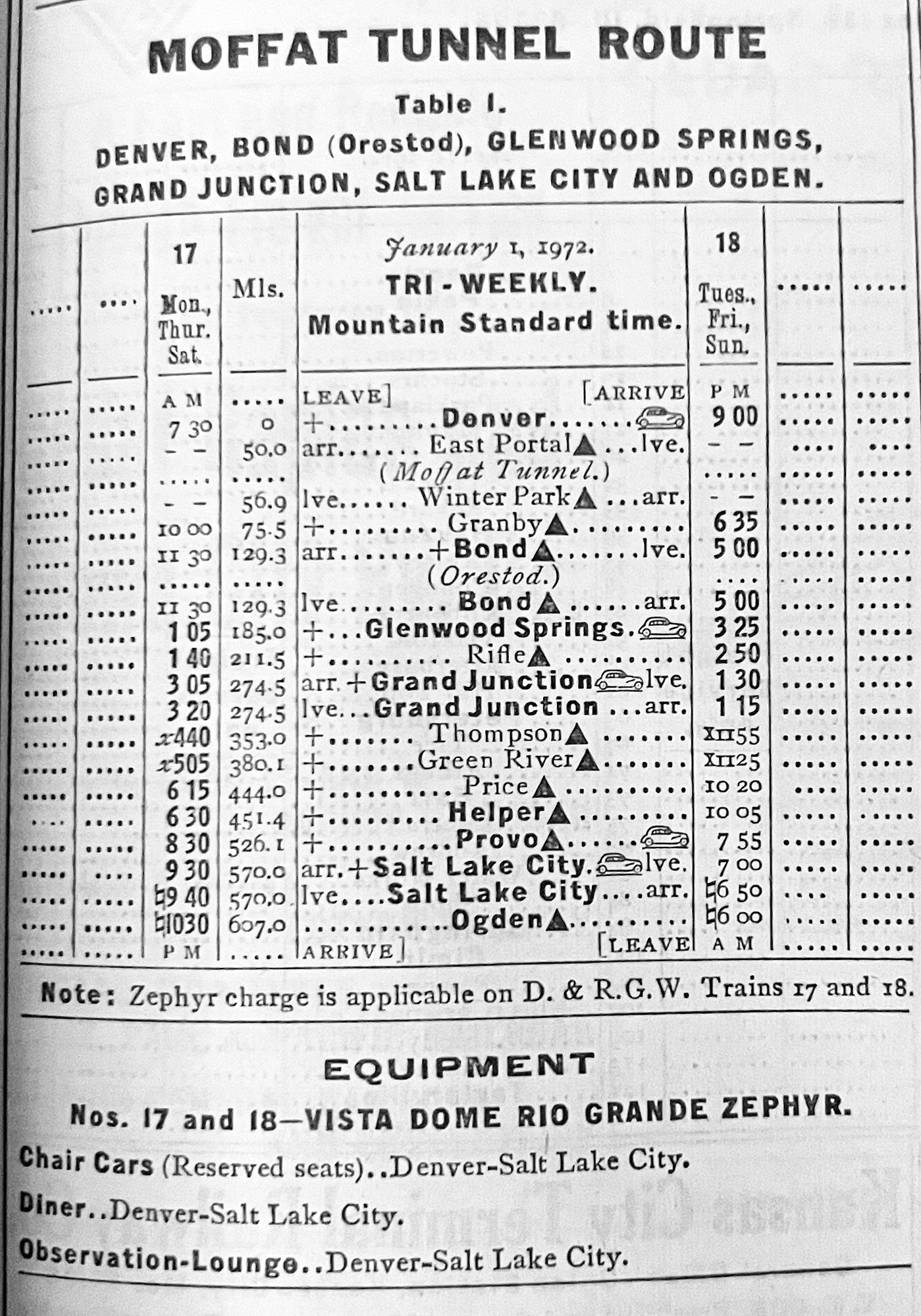"Rio Grande Zephyr" (Train): Consist, Timetable, History
Last revised: August 25, 2024
By: Adam Burns
Despite the California Zephyr's cancellation in March, 1970, ghosts of the train lingered for many years. While the Western Pacific had had enough with passenger service both the Burlington Northern and Rio Grande continued to host tri-weekly service, per Interstate Commerce Commission directive as the California Zephyr Service, or simply "California Service."
It was never a particularly popular train and always ran with only a few cars. When Amtrak began on May 1, 1971 the Rio Grande elected to continue hosting passenger service and did not join the national carrier.
It would introduce the Rio Grande Zephyr from Denver to Ogden. Interestingly, the RGZ, using former California Zephyr dome cars and equipment, enjoyed relatively strong ridership over part of its route through the late 1970s.
The RGZ, like the "California Service," was tri-weekly. It continued to operate privately for more than 12 years before the Rio Grande finally ended the train due rising costs and aging equipment.
Photos
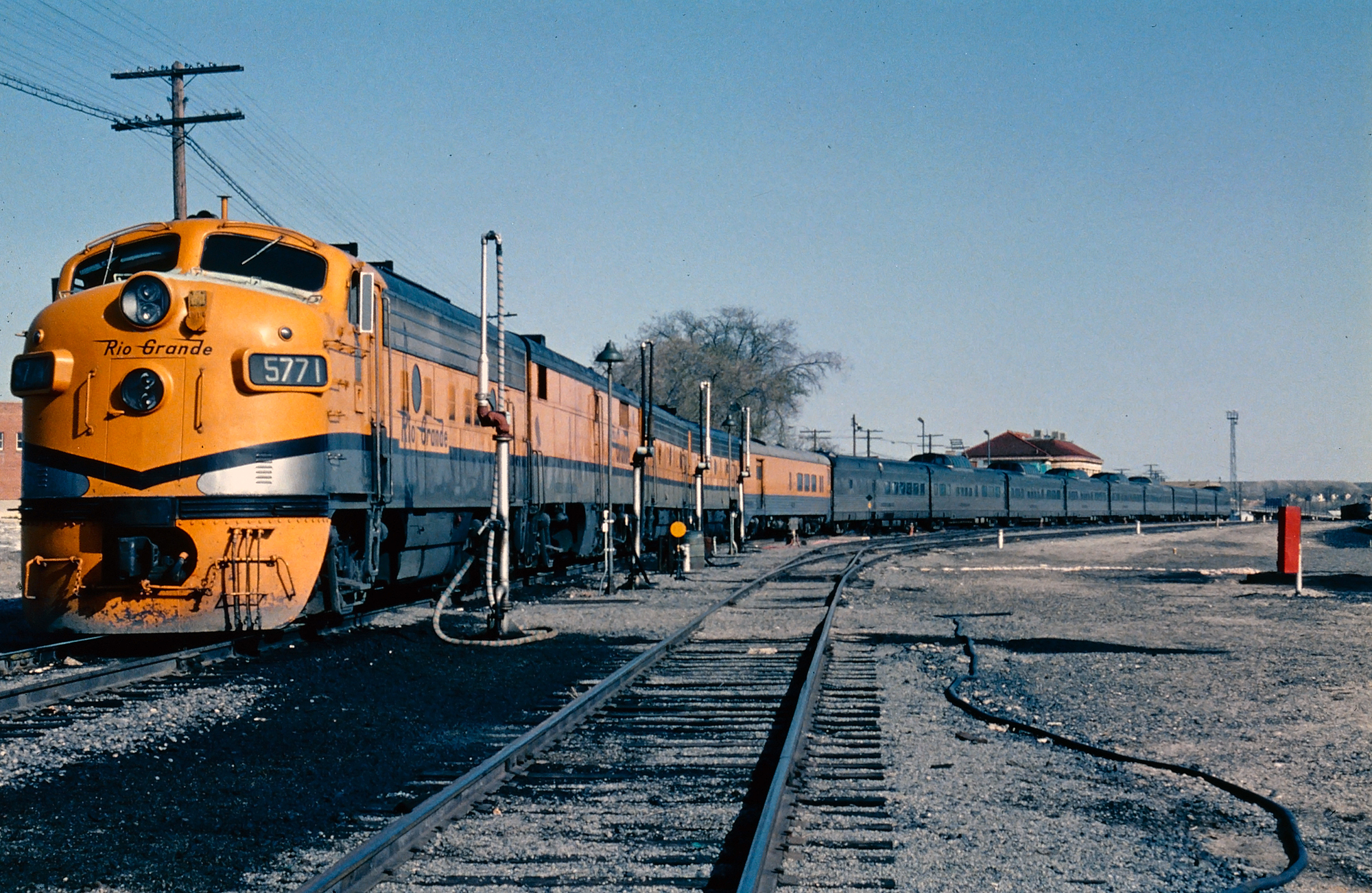 Rio Grande F9A #5771 leads one of the final runs of the "Rio Grande Zephyr" as the train is serviced at Grand Junction, Colorado in the early spring of 1983. Mike Bledsoe photo. American-Rails.com collection.
Rio Grande F9A #5771 leads one of the final runs of the "Rio Grande Zephyr" as the train is serviced at Grand Junction, Colorado in the early spring of 1983. Mike Bledsoe photo. American-Rails.com collection.History
On May 1, 1971 Amtrak began operations, a quasi-government entity that took over most intercity rail services across the country and largely relieved the private freight railroads from this money-losing burden.
However, for various reasons some roads elected not to join Amtrak and continued operating their own trains. The Rio Grande was one such renegade although its reasoning was largely financial in nature.
As a prerequisite to joining Amtrak, railroads were required to pay a fee equal to revenues lost on passenger operations in an average year.
They were also subject to annual incremental fees of operating the trains. It seems the Rio Grande felt the more economical route was to operate the RGZ itself and thus sidestepped Amtrak.
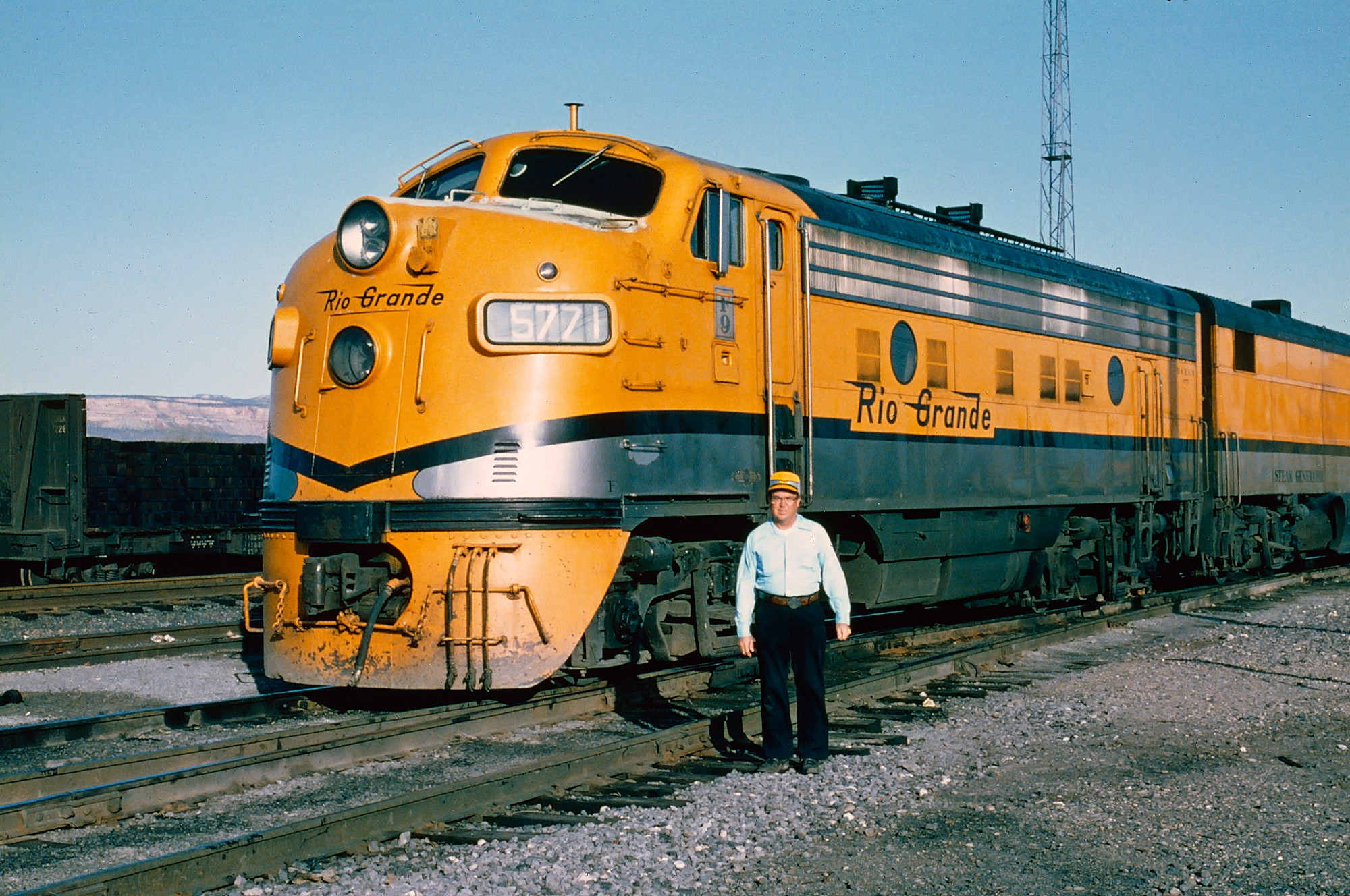 Mike Bledsoe (whose photography is featured throughout this website) poses in front of the "Rio Grande Zephyr" stopped at Grand Junction, Colorado in 1983. Dave Schumacher photo. American-Rails.com collection.
Mike Bledsoe (whose photography is featured throughout this website) poses in front of the "Rio Grande Zephyr" stopped at Grand Junction, Colorado in 1983. Dave Schumacher photo. American-Rails.com collection.Consist
EMD F9's (A-B or A-B-B)
Steam Generator Car (Ex-Alco PB-1)
Combine #1230/1231
Coach: Silver Aspen
Coach: Silver Pine
"Vista-Dome" Coach: Silver Bronco
"Vista-Dome" Chair Car: Silver Pony
"Vista-Dome" Chair Car: Silver Colt
"Vista-Dome" Chair Car: Silver Mustang
"Vista-Dome" Dormitory-Buffet-Lounge Car: Silver Shop
Diner (48 seats): Silver Banquet
"Vista-Dome" Buffet-Lounge-Observation: Silver Sky
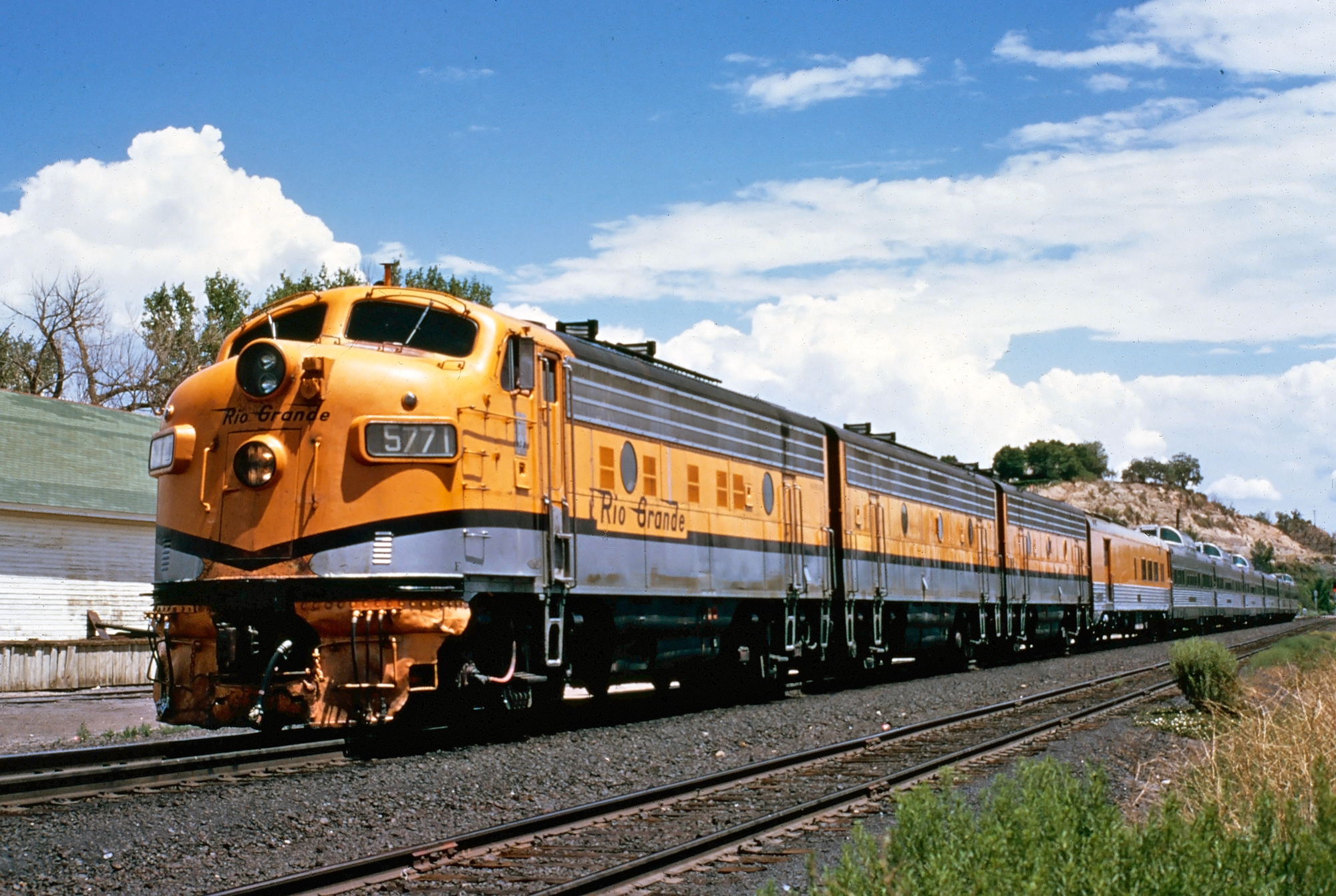 Rio Grande F9A #5771 leads the "Rio Grande Zephyr" at Rifle, Colorado circa 1975. Robert Eastwood Jr. photo. American-Rails.com collection.
Rio Grande F9A #5771 leads the "Rio Grande Zephyr" at Rifle, Colorado circa 1975. Robert Eastwood Jr. photo. American-Rails.com collection.At A Glance
15 Hours (Westbound) 15 Hours (Eastbound) |
|
17 (Westbound) 18 (Eastbound) | |
Union Station (Denver) Union Station (Ogden, Utah) |
In response, the national carrier launched its own version of the California Zephyr, which it called the San Francisco Zephyr. Unfortunately, the SFZ was neither as scenic nor offered the services of its predecessor (no domes and pre-heated/cooked meals were the norm).
It utilized the Burlington's main line as far as Denver but then turned north to Cheyenne via the Union Pacific until reaching Salt Lake City/Ogden. From this point the train ran on Southern Pacific trackage into the Bay Area.
Official Guide Listing (1972)
In an age when rail travel was looked upon as antiquated and outdated the Rio Grande Zephyr was a fine train. Its tri-weekly service continued to run with domes (some of which were converted from sleepers) and full-service dining was maintained for more than 12 years.
In his book, "Rio Grande Railroad," author James Griffin notes that at first the Rio Grande Zephyr was witnessed only light patronage. However, by the late 1970s the train ran mostly full between Denver and Glenwood Springs as Denver residents used the RGZ for overnight stays in the latter city.
While the train ran mostly empty west of Glenwood Springs it nevertheless was enjoying all-time high ridership by the early 1980s.
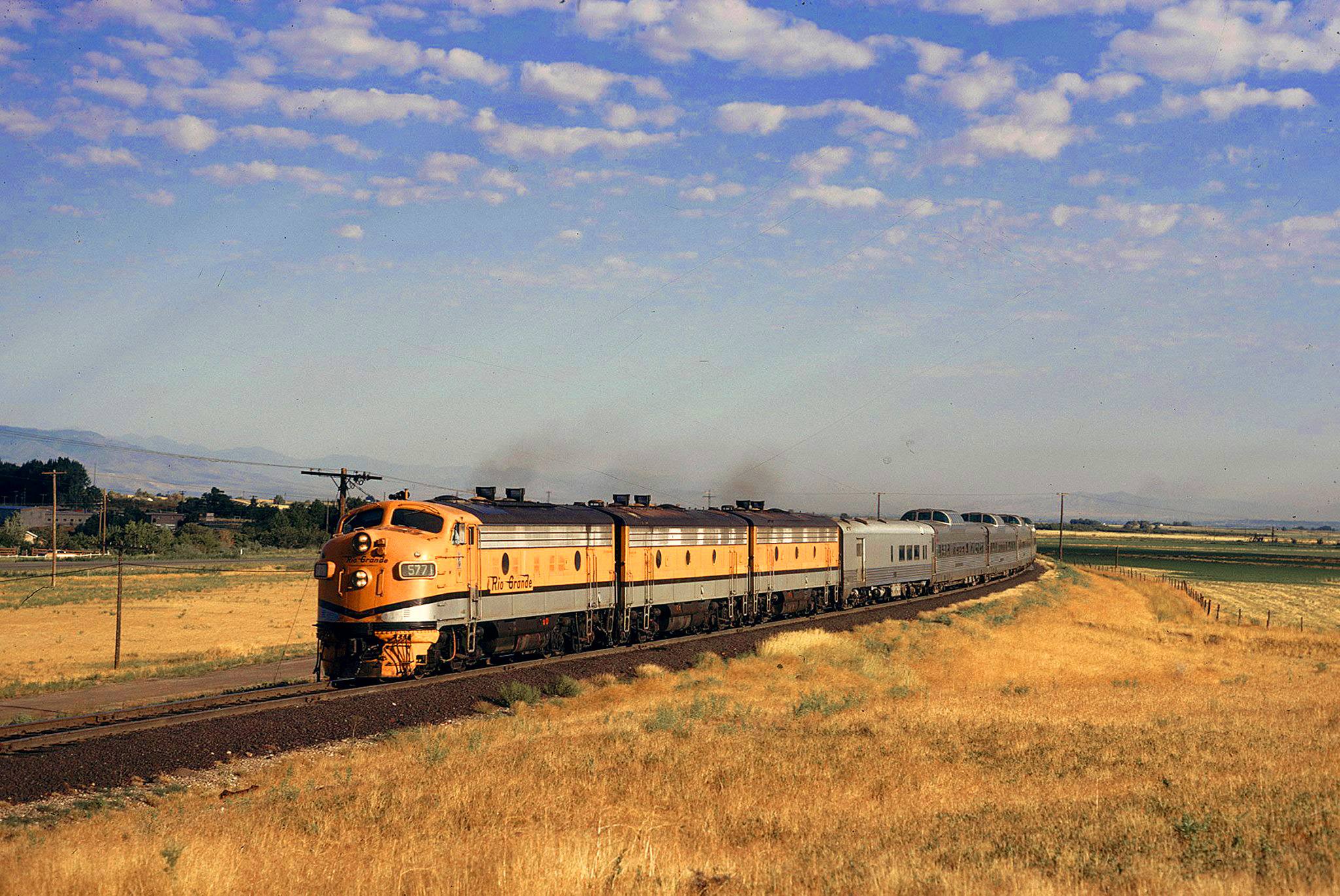 An A-B-B set of Rio Grande F9's hustle the eastbound "Rio Grande Zephyr" south of Spanish Fork, Utah, before its climb over Soldier Summit, during August of 1973. Drew Jacksich photo.
An A-B-B set of Rio Grande F9's hustle the eastbound "Rio Grande Zephyr" south of Spanish Fork, Utah, before its climb over Soldier Summit, during August of 1973. Drew Jacksich photo.Final Years
Alas, with a difficult decision as operating and labor costs continued to climb the Rio Grande eventually understood the logical and obvious choice to hand over the country's last privately operated passenger train to Amtrak.
In a New York Times article entitled "Rail Buffs Bid Adieu To Rio Grande Zephyr" by William Schmidt published on April 24, 1983 the paper covered its final run west from Denver on April 23rd. The engineer that day was John Schoening whose train was packed with 375 passengers with tickets having sold out weeks in advance.
Timetable (January 1, 1972)
Tri-Weekly
| Time/Read Down (Train #17) | Milepost | Time/Read Up (Train #18) | |
|---|---|---|---|
| 7:30 AM (Depart) | 0.0 | 9:00 PM (Arrive) | |
| 50.0 | |||
| 56.9 | |||
| 10:00 AM | 75.5 | 6:35 PM | |
| 11:30 AM | 129.3 | 5:00 PM | |
| 1:05 PM | 185.0 | 3:25 PM | |
| 1:40 PM | 211.5 | 2:50 PM | |
| 3:05 PM (Arrive) | 274.5 | 1:30 PM (Depart) | |
| 3:20 PM (Depart) | 274.5 | 1:15 PM (Arrive) | |
| 4:40 PM | 353.0 | 11:55 AM | |
| 5:05 PM | 380.1 | 11:25 AM | |
| 6:15 PM | 444.0 | 10:20 AM | |
| 6:30 PM | 451.4 | 10:05 AM | |
| 8:30 PM | 526.1 | 7:55 AM | |
| 9:30 PM (Arrive) | 570.0 | 7:00 AM (Depart) | |
| 9:40 PM (Depart) | 570.0 | 6:50 AM (Arrive) | |
| 10:30 PM (Arrive) | 607.0 | 6:00 AM (Depart) |
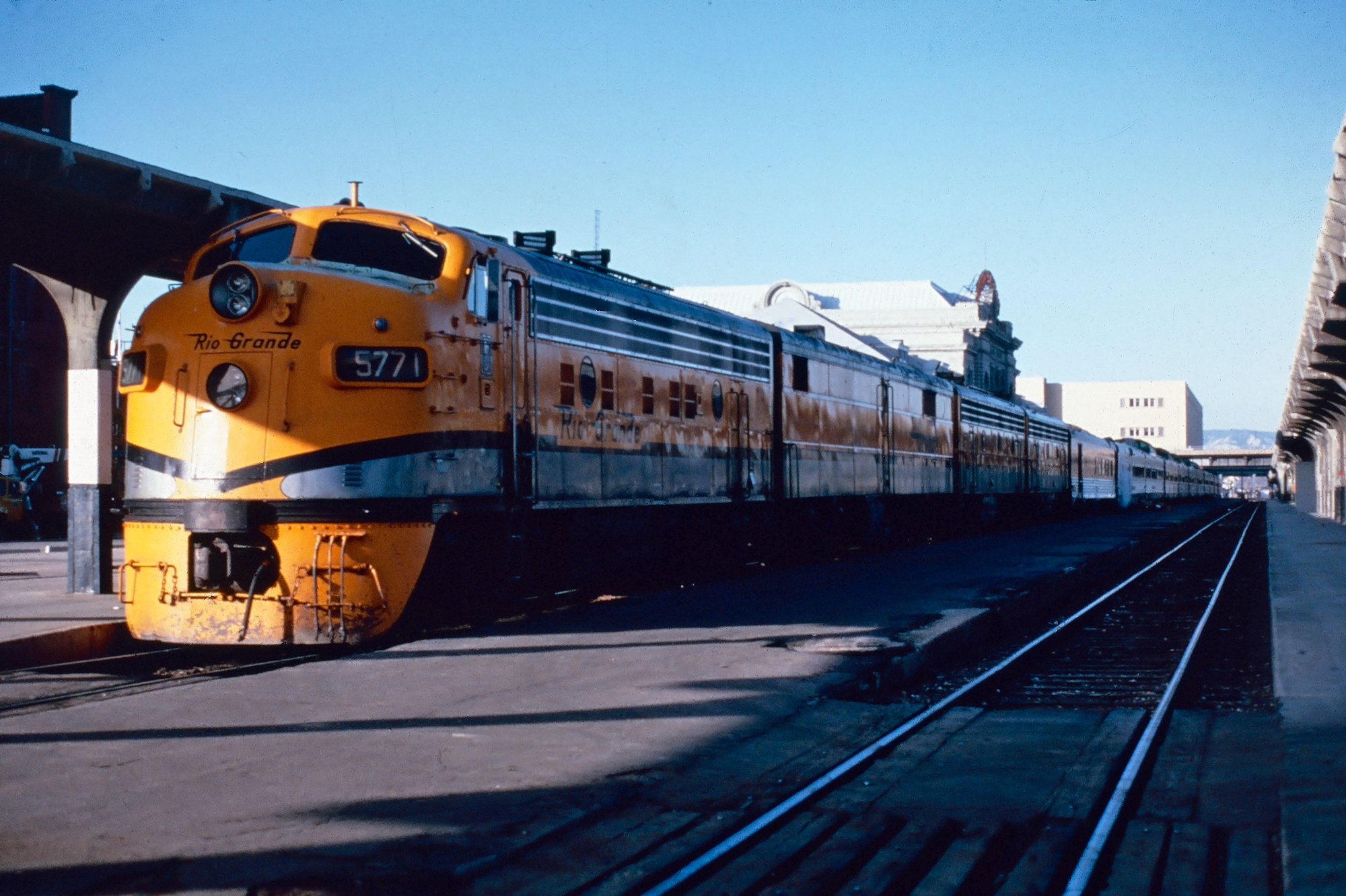 Rio Grande F9A #5771 at Denver Union Station with the "Rio Grande Zephyr," circa 1975. Robert Eastwood, Jr. photo. American-Rails.com collection.
Rio Grande F9A #5771 at Denver Union Station with the "Rio Grande Zephyr," circa 1975. Robert Eastwood, Jr. photo. American-Rails.com collection.It left Denver Union Station at 7:30 AM and made history as not only the final privately operated passenger train but also the last to offer full-service dining, an amenity which has never returned to this day.
The Times article quoted Rio Grande's director of passenger and dining car services at the time, Leonard Bernstein, who stated, "I've obviously got mixed emotions but I'm looking forward to Amtrak taking over the route. I think their service is getting better all the time."
Considering the carrier's chronic lack of on-aboard accommodations since then some will likely disagree with his assessment. After the RGZ's last run, Amtrak reinstated the California Zephyr name and, after a delay due to a mudslide, returned its routing via Rio Grande trackage on July 16th that year.
Sources
- Griffin, James R. Rio Grande Railroad. St. Paul: Voyageur Press, 2003.
- Laidlaw, R.J. (Manager), Coyle, F. (Assistant Manager). Official Guide Of The Railways And Steam Navigation Lines Of The United States, Porto Rico, Canada, Mexico, and Cuba, The. Volume 104. Issue 12. Page 309. New York: National Railway Publication Company, 1972.
- Schafer, Mike and Welsh, Joe. Streamliners, History of a Railroad Icon. St. Paul: MBI Publishing, 2003.
Recent Articles
-
Wisconsin Dinner Train Rides In North Freedom!
Jan 06, 26 10:18 PM
Featured here is a practical guide to Mid-Continent’s dining train concept—what the experience is like, the kinds of menus the museum has offered, and what to expect when you book. -
Pennsylvania Dinner Train Rides In Boyertown!
Jan 06, 26 06:48 PM
With beautifully restored vintage equipment, carefully curated menus, and theatrical storytelling woven into each trip, the Colebrookdale Railroad offers far more than a simple meal on rails. -
North Carolina ~ Murder Mystery ~ Dinner Train Ride
Jan 06, 26 11:26 AM
While there are currently no murder mystery dinner trains in the Tarheel State the Burgaw Depot does host a murder mystery dinner experience in September! -
Florida's - Murder Mystery - Dinner Train Rides
Jan 06, 26 11:23 AM
Florida, known for its vibrant culture, dazzling beaches, and thrilling theme parks, also offers a unique blend of mystery and fine dining aboard its murder mystery dinner trains. -
New Mexico's - Wine Tasting - Train Rides
Jan 06, 26 11:19 AM
For oenophiles and adventure seekers alike, wine tasting train rides in New Mexico provide a unique opportunity to explore the region's vineyards in comfort and style. -
Ohio's - Wine Tasting - Train Rides
Jan 06, 26 11:14 AM
Among the intriguing ways to experience Ohio's splendor is aboard the wine tasting trains that journey through some of Ohio's most picturesque vineyards and wineries. -
Connecticut's Thomas The Train Rides
Jan 06, 26 11:06 AM
For 2026, the tour stop at Essex brings Thomas (and Percy, too) to the historic Valley Railroad for a full day of events for the kids. -
Maryland's Thomas The Train Rides
Jan 06, 26 11:00 AM
In 2026, the B&O Railroad Museum in Baltimore welcomes the Let’s Rock, Let’s Roll Tour with four event days that combine a Thomas-themed excursion with other activities. -
Tennessee's Thomas The Train Rides
Jan 06, 26 10:51 AM
Set on the grounds of one of the Southeast’s best-known operating railroad museums, the Thomas the train event blends kid-friendly fun with the unmistakable sights, sounds, and atmosphere of a real wo… -
Georgia's Thomas The Train Rides
Jan 06, 26 10:44 AM
Day Out With Thomas is set to roll back into Cordele in 2026, bringing Thomas the Tank Engine and a full family festival to the SAM Shortline at Georgia Veterans Memorial State Park. -
Staten Island Rapid Transit
Jan 06, 26 10:02 AM
The Staten Island Rapid Transit has long served Staten Island since the 19th century and today is known as the Staten Island Railway. -
New York Dinner Train Rides In The Adirondacks!
Jan 05, 26 09:45 PM
Operating over a restored segment of the former New York Central’s Adirondack Division, the Adirondack Railroad has steadily rebuilt both track and public interest in passenger rail across the region. -
Ohio Dinner Train Rides On The CVSR!
Jan 05, 26 08:32 PM
While the railroad is well known for daytime sightseeing and seasonal events, one of its most memorable offerings is its evening dining program—an experience that blends vintage passenger-car ambience… -
Pennsylvania's - Wine Tasting - Train Rides
Jan 05, 26 01:08 PM
Wine tasting trains are a unique and enchanting way to explore the state’s burgeoning wine scene while enjoying a leisurely ride through picturesque landscapes. -
West Virginia - Wine Tasting - Train Rides
Jan 05, 26 01:02 PM
West Virginia, often celebrated for its breathtaking landscapes and rich history, offers visitors a unique way to explore its rolling hills and picturesque vineyards: wine tasting trains. -
Virginia - Wine Tasting - Train Rides
Jan 05, 26 12:58 PM
Wine tasting trains in Virginia provide just that—a unique experience that marries the romance of rail travel with the sensory delights of wine exploration. -
Utah - Wine Tasting - Train Rides
Jan 05, 26 12:37 PM
Utah, a state widely celebrated for its breathtaking natural beauty and dramatic landscapes, is also gaining recognition for an unexpected yet delightful experience: wine tasting trains. -
Kentucky Valentine's Train Rides
Jan 05, 26 12:31 PM
If you’re looking for a date night that feels a little more cinematic than the usual reservation-and-a-movie routine, Bardstown’s My Old Kentucky Dinner Train delivers the kind of evening you remember… -
Pennsylvania Valentine's Train Rides
Jan 05, 26 12:12 PM
Tucked amid the rolling farmland of Lancaster County, Pennsylvania, the Strasburg Rail Road stands as one of the most celebrated and successful heritage railroads in North America. -
New York's - Murder Mystery - Dinner Train Rides
Jan 05, 26 11:01 AM
New York State, renowned for its vibrant cities and verdant countryside, offers a plethora of activities for locals and tourists alike, including murder mystery train rides!

